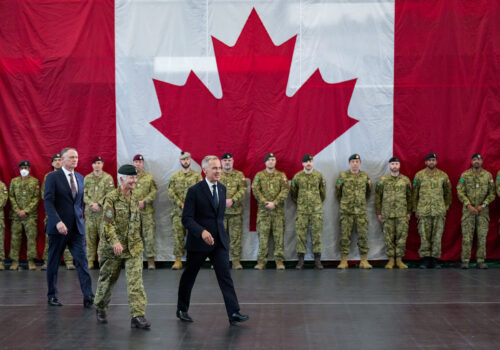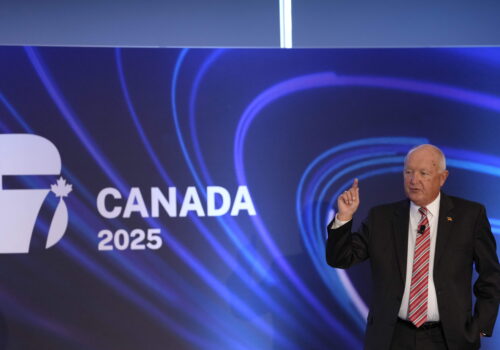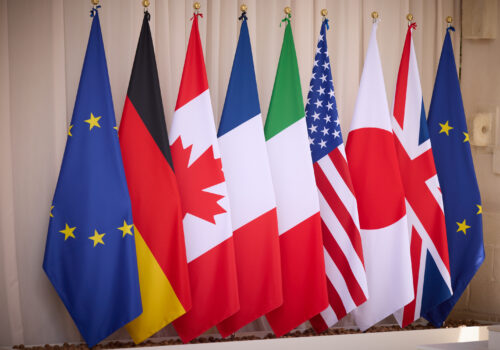It’s a high-stakes summit among the high summits. Leaders from the Group of Seven (G7) nations are set to convene in the Rocky Mountain resort of Kananaskis, Alberta, Canada, from June 15 to 17. This year also marks the group’s fiftieth meeting. In 1975, the newly created Group of Six (G6) held its first meeting in France amid oil price shocks and financial fallout from then US President Richard Nixon’s decision to remove the dollar from the gold standard. In recent years, the G7 has coalesced around coordinating sanctions on Russia, supporting Ukraine’s reconstruction, and responding to Chinese manufacturing overcapacity. But 2025 comes with new challenges, including an ongoing trade war between G7 members, which will test the resolve and the raison d’etre of the grouping.
Here’s a look inside the numbers that will frame the summit.
The G7 was formed fifty years ago so the world’s advanced-economy democracies could align on shared economic and geopolitical challenges. But what happens when the cause of instability is coming from inside the G7? That’s the question confronting the leaders as they assemble this week in Kananaskis.
US President Donald Trump is still getting to know some of his new colleagues, including German Chancellor Friedrich Merz, UK Prime Minister Keir Starmer, Japanese Prime Minister Shigeru Ishiba, and the summit’s host, Canadian Prime Minister Mark Carney. Trump will try to coordinate the group against China’s economic coercion. But the rest of the leaders may turn back to Trump and say that this kind of coordination, which is at the heart of why the G7 works, would be easier if he weren’t imposing tariffs on his allies. The chart above shows the friction points heading into one of the most consequential G7 summits in the organization’s history.
—Josh Lipsky is the chair of international economics at the Atlantic Council, senior director of the GeoEconomics Center, and a former adviser to the International Monetary Fund (IMF).
Originally created as an economic coordination body, the G7 began to put foreign policy and national security on its agenda in the 1980s, as the Soviet Union’s political influence was waning. Soon after, Russia attended its first G7 Summit as a guest in 1991, formally joined in 1998, creating the Group of Eight (G8), and then was suspended in 2014 due to its annexation of Crimea.
In the years since, new geopolitical rivals have entered the fray: Since the COVID-19 pandemic, G7 summits and declarations have attempted to address China’s role in the global economy. Last year’s leaders’ communiqué was especially harsh on China—which was mentioned twenty-nine times—on everything from its material support to Russia’s war against Ukraine to Beijing’s malicious cyber activities. But China was once a guest at the forum, first joining in this capacity in 2003.
Other members of the G7+5, an unofficial grouping of large emerging markets—India, Mexico, Brazil, and South Africa—have been invited as guests in recent years. If that sounds familiar, it is because India, Brazil, and South Africa, along with Russia and China, are the founding members of the BRICS group of emerging economies, which some would consider a representation of the geopolitical and economic competition the G7 faces today.
This year, Australia, Ukraine, South Korea, Brazil, Mexico, and India were invited to attend as guests. These invitations are a signal of broad alignment among the G7 and its guests. These invitations demonstrate the importance of the guests’ economic might on the global stage, even though India has shifted away from the G7 quite significantly in the last fifty years, as seen in the graph above. In 1992, when Russia first attended the G7 as a guest, its gross domestic product (GDP) was less than 1 percent of the world’s GDP, and the combined economies of the five founding BRICS countries made up less than 9 percent of global GDP. At the time, the G7 represented 63 percent of the world’s GDP. Today, the G7’s share is now 44 percent of the world’s GDP and the founding BRICS members’ share has more than doubled to almost 25 percent.
—Ananya Kumar is the deputy director for future of money at the Atlantic Council’s GeoEconomics Center.
In 2024, G7 countries attracted over 80 percent of global private artificial intelligence (AI) investments, led primarily by the United States. In ten years, private AI investments have grown almost fifteen-fold. This month, the US Department of Commerce rebranded its AI Safety Institute as the Center for AI Standards and Innovation (CAISI)—shifting away from an emphasis on “safety” and toward promoting rapid commercial development.
Carney has said that he plans to put AI at the top of his agenda at the upcoming G7 Leaders’ Summit. He has been a long-standing advocate of AI—dating back to his 2018 presentation on AI and the global economy while he was governor of the Bank of England.
But while the United States leads in AI innovation and investment, Europe continues to set the pace on regulation, and China strategically develops its own AI models. All this leaves Canada asking where it fits in.
That may be why Carney hopes to lead on this issue. The G7 presidency offers Canada a unique opportunity to convene democracies to work together on AI. Rather than trying to outspend the United States or out-regulate Europe, Canada can focus on building connections—creating shared standards, developing trusted public-private data hubs, coordinating strategic investments, and outlining guidelines for common learning and collaboration across borders.
—Alisha Chhangani is an assistant director at the Atlantic Council’s GeoEconomics Center.
Ten years after the first G6 meeting took place in France, another landmark meeting took place at the Plaza Hotel in New York, in September 1985. At the meeting, then US Treasury Secretary James Baker convinced his counterparts from West Germany, France, the United Kingdom, and Japan to support a significant devaluation of the US dollar—what became known as the Plaza Accord.
Today, the dollar’s value relative to its G7 counterparts is on the rise again, fueled by tight monetary policy and expansionary fiscal spending. Although the current appreciation is milder than the surge seen in the early 1980s, the Trump administration may use the G7 Summit to raise concerns about the burden of being the world’s reserve currency, especially when it comes to export competitiveness. In late 2024, the current chair of Trump’s Council of Economic Advisers, Stephen Miran, proposed a “Mar-a-Lago Accord” as an updated version of the Plaza Accord, though no real progress on this is apparent. Moreover, this time a key global player is absent from the conversation—China.
—Bart Piasecki is an assistant director at the Atlantic Council’s GeoEconomics Center.
The finance ministers and central bank governors of the G7 already held their meeting last month in the Canadian Rockies, emerging with a consensus on tackling “excessive imbalances” and nonmarket policies. While the G7’s finance ministers and central bank governors’ communiqué didn’t call out China by name, it’s clear that’s who they were referring to. Simultaneously, the US-UK trade deal called for the United Kingdom to meet US requirements on the security of supply chains, which infuriated Beijing.
Washington wants coordinated economic security partnerships to help counter China and encourage more investment in the United States. But the United States has been calling for allies to divest from China for a while now. In response, G7 counterparts could point to the data above and ask: How much more do we need to give?
Over the past five years, nearly every G7 country, with the exception of Canada, has scaled down their investments in China and scaled up their investments in the United States. For example, Japan has reduced foreign direct investment in China by 60 percent over the past decade, including shuttering a major Honda plant in Guangzhou. Meanwhile, the Japanese carmaker pledged to put $300 million into a plant outside of Columbus, Ohio. This has been the trend as the United States’ G7 partners reassess their economic dependencies on China. But amid ongoing trade wars, how much are they willing to coordinate more closely with the United States?
—Jessie Yin is an assistant director with the Atlantic Council’s GeoEconomics Center.
Foreign aid, or official development assistance (ODA), from G7 countries dropped sharply in 2024, and early projections through 2025 and 2026 suggest even steeper declines ahead for most nations. The United States has exhibited the most drastic retreat, following the effective dismantling of the US Agency for International Development. But European countries have also scaled back development budgets and are redirecting funds toward defense and domestic economic issues. While ODA briefly surged in response to the COVID-19 pandemic and the war in Ukraine, that uptick masked a longer-term downward trend in traditional development funding as a percentage of G7 countries’ economies.
Most G7 nations have failed for years to meet the United Nations Sustainable Development Goals Target 17.2, which called for allocating 0.7 percent of gross national income to ODA. As of 2024, none of them has reached this benchmark. This retreat is particularly troubling given today’s fractured geopolitical and economic landscape. In such times, investing in global partnerships and life-saving aid through ODA is not just a moral imperative—it’s also a strategic one.
—Lize de Kruijf is a program assistant at the Atlantic Council’s Economic Statecraft Initiative.
A major focus heading into the G7 Summit will be how Carney handles his latest meeting with Trump. The two managed to have a cordial meeting in May, and Carney’s announcement this week that Canada will increase its defense spending could help to placate Trump, who has long complained about Canada’s lagging defense spending.
But Canada is also looking beyond its southern neighbor. Carney has invited the leaders of Australia, Brazil, India, Indonesia, Mexico, South Korea, South Africa, Ukraine, and Saudi Arabia to join him in Alberta. Under former Prime Minister Justin Trudeau, Canada’s relationships with both Saudi Arabia and India reached diplomatic low points. By inviting these leaders, Carney is demonstrating a willingness to reengage partners. In no area is Carney more likely to pursue new partnerships than in the defense sector. Canada stated its desire to join the ReArm Europe Initiative and has signed a major deal for an Australian radar system. Expect Carney to seek new partners as Canada rebuilds its defense capacity, potentially with some of the countries invited to this year’s G7.
—Imran Bayoumi is an associate director at the Atlantic Council’s Scowcroft Center for Strategy and Security.
Canada’s hosting of the G7 Summit in Alberta carries exceptional significance amid escalating tensions with the United States. Trump’s attendance, which will mark his first G7 Summit since 2019, signals renewed engagement with Canada. This could spark talks on renegotiating the United States-Mexico-Canada Agreement (USMCA) ahead of the trade deal’s first joint review in July 2026. The timing of the G7 Summit coincides with heightened Canadian nationalism and intense public focus on Canada-US relations, particularly around tariff disputes affecting sectors such as steel.
The Trump-Carney relationship differs markedly from previous dynamics between Trudeau and Trump, potentially enabling more productive G7 cooperation when US foreign policy dominates global conversations. The trilateral presence of Mexican President Claudia Sheinbaum, Trump, and Carney creates an opportunity for preliminary USMCA discussions. However, critical questions emerge: Will Mexico and Canada align against the Trump administration? Will Canada prioritize repairing bilateral US relations over Mexico-Canada ties? The summit’s outcome is likely to significantly shape hemispheric trade relationships and regional diplomatic strategies.
—Maite Gonzalez Latorre is a program assistant at the Adrienne Arsht Latin America Center and Caribbean Initiative.
Sophia Busch, Ella Wiss Mencke, Ethan Garcia, and Miguel Sanders contributed to the data visualizations in this article. The data visualization titled “US jobs rely on Mexico and Canada more than any other trade partner” originally appeared in an article by Sophia Busch published on January 16, 2025.
Further reading
Wed, Jun 11, 2025
Carney’s ‘hinge moment’ is about more than just Canadian defense spending. What does that mean for Washington?
New Atlanticist By Imran Bayoumi
The Canadian prime minister gave his first major defense and security speech on June 9, describing an unraveling international order and an increasingly unreliable United States.
Fri, Jun 6, 2025
G7 leaders have the opportunity to strengthen digital resilience. Here’s how they can seize it.
GeoTech Cues By Sara Ann Brackett, Coley Felt, Raul Brens Jr.
At the upcoming Group of Seven Leaders’ Summit in Canada, member state leaders should advance a coherent, shared framework for digital resilience policy.
Fri, Feb 28, 2025
Canada’s G7 presidency should prioritize health innovation
New Atlanticist By
Canada should use its G7 presidency to communicate the long-term economic benefits of investing in health innovation.
Image: Fish and Wildlife officers patrol the area in Kananaskis Country, where the leaders of the G7 will meet from June 15 to 17, 2025 in Alberta, Canada, June 9, 2025. REUTERS/Todd Korol.




